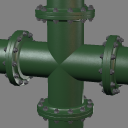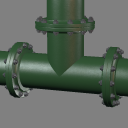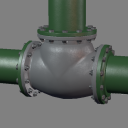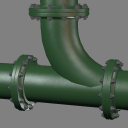Table of Contents
Pipe sizes
The pipe kit comes in 3 “standard” diameters: 1m, 30 cm, 10 cm.
All the pieces can be resized to suit your needs but the bolts, flanges and other fixtures are realistically scaled at their default dimensions.
Straight pipes are made using prim-cylinders (examples provided), something that already exists, is fairly efficient, and only costs 0.5-1LI.
Curved pieces
The original reason behind the curved parts was that, when using materials, cut toruses (prims) have a tendency to baloon up to 10 LI or more.
The KDC pipe kit comes with a set of simple curved pieces in 45° 90° and 180° and with 3 different turn rates, they all cost 1LI (or less when linked), with the exception of some of the 1m versions and S-bends.
Flanges
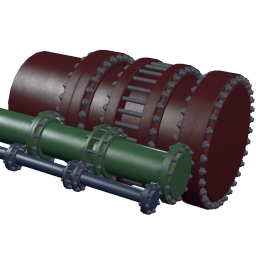 The idea behind the slip-on flanges of the KDC pipe system is that you can place them anywhere you want on your pipe network and easily hide gaps between mesh pieces and prims, without having to use pinpoint accuracy.
The idea behind the slip-on flanges of the KDC pipe system is that you can place them anywhere you want on your pipe network and easily hide gaps between mesh pieces and prims, without having to use pinpoint accuracy.
- They are filled-in on both ends so they can also double as a “capped” pipe end.
- They can be independently colored and textured to connect separate pipe networks (blue and green, rusty and clean?)
- The “wide” versions provide a small gap and long bolts to insert your own equipments and devices, or simply to make your pipe more visually interesting.
Manifolds
Kyrah, why is there no manifolds in the kit??? (those 3 way, 4 way, 5 way joints that are oh, so important to a pipe network)
The kit doesn't contain any manifold (with the exception of the second use of the globe/check valve body) because having manifolds as a separate piece isn't very LI efficient, since it would require to “break” your continuous pipe (1 prim = 1 LI) into two (or more) separate pieces, when you can simply make two (or more) pipe sections touch at 90° and add a couple of flanges around it instead.
Valves
Each pipe set comes with an assortment of valves in styles that suit that pipe type.
1 meter valves
Knife valve
 Also called a gate valve, it is the kind you might find on a large power plant or a hydro-electric dam, their body house a massive metal disc that can be moved in and out of the liquid flow.
Also called a gate valve, it is the kind you might find on a large power plant or a hydro-electric dam, their body house a massive metal disc that can be moved in and out of the liquid flow.
In the real world, these open very slowly.
They also aren't designed to be partially open, as pressure can bend the gate over time if it isn't fully closed or open.
Butterfly valve
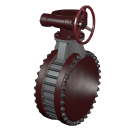 Rotates a large disc inside the pipe they are attached to, they take a lot less space and are cheaper than a gate valve, but they limit the flow a lot and have a much shorter lifespan.
Rotates a large disc inside the pipe they are attached to, they take a lot less space and are cheaper than a gate valve, but they limit the flow a lot and have a much shorter lifespan.
Large butterfly valves pretty much require a gearbox to get the torque required to break the initial pressure seal.
Note: the 1m butterfly valve top fits 30cm compatible flange.
Hydraulic sewage valve
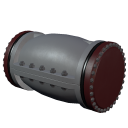 It doesn't look like much, but there valves are typically used in waste processing facilities and other places that handle semi-solids and/or thick products. These aren't actuated directly: They contain a thick rubber liner that pinches itself shut when the valve body is filled with air or hydraulic fluid.
It doesn't look like much, but there valves are typically used in waste processing facilities and other places that handle semi-solids and/or thick products. These aren't actuated directly: They contain a thick rubber liner that pinches itself shut when the valve body is filled with air or hydraulic fluid.
Ideally you want to have one or two smaller pipes connected to this kind of valve to actuate it.
Note: The rubber liner can be seen between the valve body and the flanges.
30cm & 15cm valves
Butterfly valve
 Same as its big brother, they rotates a disc inside the pipe they are attached to, they take a lot less space and are cheaper than a knife valve, but they limit the flow a lot and have a much shorter lifespan.
Same as its big brother, they rotates a disc inside the pipe they are attached to, they take a lot less space and are cheaper than a knife valve, but they limit the flow a lot and have a much shorter lifespan.
Despite being much smaller, the pressure difference can still make it very difficult to open this kind of valve without an attached gearbox.
Note: the 30cm butterfly valve top fits 10cm compatible flange.
Check valves
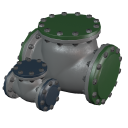 These are not manually operated, and simply contain a flap that prevents the liquid inside the pipe from flowing backward, they usually have just a lid on top for maintenance.
These are not manually operated, and simply contain a flap that prevents the liquid inside the pipe from flowing backward, they usually have just a lid on top for maintenance.
In the KDC pipe kit, this is simply a globe valve without a tower or a valve wheel. They are also built in such a way that you can use them as a 3 way manifold too. In general this is a good base to build various devices, flow meters, pressure gauges, filters, etc…
Globe valve
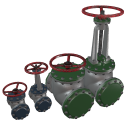 These are typically used to precisely control the flow of a liquid, they contain a “globe” shaped plug on the end of a threaded shaft that can be pushed in or out to adjust the flow of the liquid. They are rarely used as shutoff valves because of how much they limit flow.
These are typically used to precisely control the flow of a liquid, they contain a “globe” shaped plug on the end of a threaded shaft that can be pushed in or out to adjust the flow of the liquid. They are rarely used as shutoff valves because of how much they limit flow.
The KDC pipe kit has two versions, one with a visible shaft and shaft housing, and one with a simple valve handle.
Note: the 30cm tower ends with a 10cm compatible flange.
Small Knife valve (10cm only)
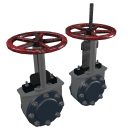 The smaller version of the knife valve for 10cm pipes has an integrated tower and the “knife” is exposed when the valve is open.
The smaller version of the knife valve for 10cm pipes has an integrated tower and the “knife” is exposed when the valve is open.
Don't pinch your fingers with it!
Support structures
The kit comes with an assortment of frames, mounting collars and support pillars, so they can be attached to the ground, ceiling, or walls.
In general threaded rod supports are anchored only to the floor, or the ceiling (because they can bend otherwise), but for smaller pipes, wall mounting is okay.
Misc parts
Valve wheels, shafts, gearbox.
Scripts
The valves come pre-scripted by default, the scripts are always inside the valve wheel link piece (this way only the valve wheel itself is clickable).
There are two versions for each valve:
- Analog: Can be finely operated by clicking and dragging the mouse.
- On/Off: These use the more “standard” way of using things in SL: click to open, click to close.
The scripts are fairly extensive and heavily commented, all the parameters are at the very top of the script, free free to experiment with them, the default values are merely suggestions.
For bug reports and feature requests, all the scripts can also be found here: https://gitlab.com/KyrahAbattoir/kdc-pipe-kit
Message system
All the scripts have this function disabled by default, but if you want to build an interactive installation with the kit, by setting MESSAGE_ENABLED to TRUE, the script will report to the root prim of the current linkset the state of the valve it controls.
Refer to the comments inside the scripts for more details.
If you plan on using multiple valves in one linkset, make sure that you give them unique names, and that each shaft/gearbox is labeled uniquely.

